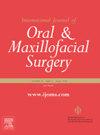形态学因素影响对侧关节镜下关节脱位术后颞下颌关节前盘移位由复位到不复位的进展:一项回顾性研究。
IF 2.7
3区 医学
Q2 DENTISTRY, ORAL SURGERY & MEDICINE
International journal of oral and maxillofacial surgery
Pub Date : 2025-04-10
DOI:10.1016/j.ijom.2025.03.012
引用次数: 0
摘要
本回顾性队列研究的目的是确定与关节镜下骨折后对侧颞下颌关节(TMJ)前盘移位伴复位(ADDwR)至不复位(ADDwoR)进展相关的形态学危险因素。在80例患者中,术后随访时根据对侧关节的椎间盘位置分为进展组26例和无进展组54例。分析患者特征及椎间盘长度、椎间盘折叠角、椎间盘相对于髁前距、椎间盘与髁间角。单因素分析显示,较长的前路距离和较大的椎间盘与髁间角度增加了ADDwoR的风险(P < 0.001),而较长的椎间盘长度(P < 0.001)和较大的椎间盘折叠角度(P = 0.034)降低了进展的可能性。多变量logistic回归和受试者工作特征曲线证实椎间盘长度和前路距离与ADDwoR进展显著相关。综上所述,单侧关节镜下discopin后,对侧ADDwR患者有发展为ADDwoR的危险,椎间盘长度和相对于髁的前距离是关键的形态学危险因素。本文章由计算机程序翻译,如有差异,请以英文原文为准。
Morphological factors influencing the progression of temporomandibular joint anterior disc displacement with reduction to without reduction after contralateral joint arthroscopic discopexy: a retrospective study
The aim of this retrospective cohort study was to identify morphological risk factors associated with the progression of temporomandibular joint (TMJ) anterior disc displacement with reduction (ADDwR) to without reduction (ADDwoR) in the contralateral joint following arthroscopic discopexy. Among 80 patients, 26 divided into a ‘progression’ group versus 54 without progression based on the disc position in the contralateral joint at postoperative follow-up. Patient characteristics and the disc length, disc folding angle, anterior distance of the disc relative to the condyle, and angle between the disc and condyle were analysed. Univariate analysis revealed that longer anterior distance and greater angle between the disc and condyle increased ADDwoR risk(both P < 0.001), while a longer disc length (P < 0.001) and a greater disc folding angle (P = 0.034) reduced progression likelihood. Multivariable logistic regression and receiver operating characteristic curves confirmed disc length and anterior distance to be significantly associated with progression to ADDwoR. In conclusion, following unilateral arthroscopic discopexy, patients with contralateral ADDwR are at risk of progression to ADDwoR, with disc length and anterior distance relative to the condyle being key morphological risk factors.
求助全文
通过发布文献求助,成功后即可免费获取论文全文。
去求助
来源期刊
CiteScore
5.10
自引率
4.20%
发文量
318
审稿时长
78 days
期刊介绍:
The International Journal of Oral & Maxillofacial Surgery is one of the leading journals in oral and maxillofacial surgery in the world. The Journal publishes papers of the highest scientific merit and widest possible scope on work in oral and maxillofacial surgery and supporting specialties.
The Journal is divided into sections, ensuring every aspect of oral and maxillofacial surgery is covered fully through a range of invited review articles, leading clinical and research articles, technical notes, abstracts, case reports and others. The sections include:
• Congenital and craniofacial deformities
• Orthognathic Surgery/Aesthetic facial surgery
• Trauma
• TMJ disorders
• Head and neck oncology
• Reconstructive surgery
• Implantology/Dentoalveolar surgery
• Clinical Pathology
• Oral Medicine
• Research and emerging technologies.

 求助内容:
求助内容: 应助结果提醒方式:
应助结果提醒方式:


